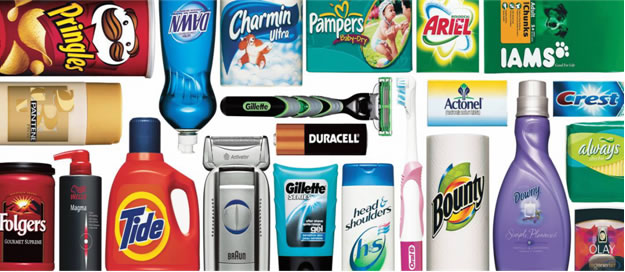Reporter: Most P&G products are sold in supermarkets and drugstores where the shelves are packed. How do you get shoppers to notice and buy your brand?
記者:很多寶潔的產品都是在超市或者藥店的貨架上進行銷售,而那些貨架往往產品種類繁多。那你們是怎樣讓消費者注意到并購買你們的產品呢?

Lafley:Ifs a huge challenge because the proliferation of brands, products and SKUs makes it difficult for the retailers to execute. These stores also have a predominantly temporary workforce and high turnover That puts a lot more pressure on package design to project an instantly recognizable brand with a clear brand promise. Consumers must clearly see who we are and what we can do for them. To do that, we try to create a category language and architecture so the shopping experience is ordered, patterned and intuitive. We spend a lot of time on that and work with our retail partners to make sure that our understanding and research are consistent with theirs. We've seen that by changing the way a product category is laid out, some retailers are realizing pretty sizable lifts in their total category business because shoppers are finding the experience easier and more intuitive.
雷富禮:那是一個很大的挑戰,因為越 來越多的品牌、產品和庫存單位使得零售商們很難對產品進行銷售,而且,這些商店里都是臨時勞動力,他們有很大的流動性。這就在包裝設計方面給我們帶來很大的壓力,我們需要規劃出一個認知度高、有良好品牌承諾的品牌。消費者必須要清楚地看到我們是誰,我們能為他們做些什么。為了實現那樣的目標,我們試著對產品進行分類,使人們的整個購物過程都很有秩序、很規范、很直觀。在那方面我們花費了很多時間,并且與零售商進行合作,以確保我們在這方面的認識與所做的研究調查和他們是一致的。我們發現,通過改變產品分類的擺放方式,很多零售商在其整體的銷售額上有很大提高,這是因為消費者發現那樣的購物方式更輕松、更自在。
Reporter:How can design make a difference to a brand and innovation company like P&G?
記者:設計對于像寶潔這樣的品牌和創新公司,其重要性是什么呢?
Lafley:Design is critical to the creation of brand equity. There are instances where we had great technology, great chemistry, but we did not get the product design or package design or the design of the delivery system right, and the consumer couldn't appreciate what the product had to offer. We have other examples where we got the design right and case with our new Swiffer duster product. It is an example of simple, but basic, good, intuitive design, and it is flying off the shelf.
雷富禮:設計對于創造品牌資產是至關重要的。有那樣的例子,當我們掌握有高科技、高化學技術,但是并沒有將產品設計、包裝設計或送遞設計做得很好,結果使得消費者不知道我們的產品會給他們帶來什么。也有實例證明,我們將設計做得很成功,結果消費者就很認同我們的產品。那就是我們的速易潔除塵 產品向我們證明的,產品設計簡單但是很基礎、很好的、很直觀,結果產品賣得很好。
Reporter:What kind of consumer research methods do you use?
記者:關于消費者調研,你們用的什么方法呢?
Lafley:Whatever works. We are relatively light users of focus groups. We prefer understanding real-world experiences. We would rather do shop - along or shopper simulations to get close to the real shopping experience. We like to get in the homes and get involved in the usage experience.
雷富禮:無論什么方法,起作用的就行。相對來說,銷售討論組的方式采用的比較少,我們更傾向于去了解真實生活中人們買東西的經歷,我們寧愿去做一些模擬,從中體會消費者購物的真實經歷,我們喜歡走進人們的生活,去了解他們使用某個產品的感受。
Reporter:P&G has been masterful at keeping brands contemporary while extending the line. An example is Crest.
記者:寶潔公司很擅長在擴大生產線的同時,保持商標與時倶進,佳潔士就是一個很好的例子。
Lafley:Crest is an interesting example because it was introduced in 1955 as a therapeutic dentifrice. It took off when we offered ;avity pn vention in the 460s and continued to grow when we added tartar control. Our more recent effort to improve the consumer experience led us to redefine Crest as “home oral care” and that opened us up to new kinds of dentifrice-flavors, forms and whitening. We had been selling manual toothbrushes and thought it would be great to offer an electric toothbrush, like experience. We got into the SpinBrush for a $3—$7 price point. Obviously we want it all to look like one Crest brand on the shelf and in the home. We work hard on the architecture because these products all have different shapes and are shelved in different places in the store.
雷富禮:佳潔士是一個很有趣的例子,因為在1955年,它是作為一種治療性的牙膏而進入市場的。上世紀60年代增加防蛀功效后這一品牌開始騰飛,而后增添的防止牙潔石的功效使其持續增長。我們最近的調杳研究引導我們將佳潔士重新定義為“家庭□腔護理”,而這將我們帶進了一個新的領域,即要注重香味、外觀以及美白。我們以前一直在賣手動牙刷,后來覺得引進電動牙刷會是一件了不起的事情,因而我們發明了佳潔士電動牙刷,定價為3-7美元。我們想把所有這些產品都歸于佳潔士這個品牌之下,所以我們不斷地努力調整它們的外形,因為外形不同,它們都被擺在貨架上不同的位置。











